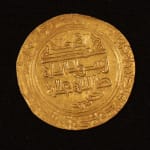Abbasid Gold Dinar Minted Under Nasr Al-Din Allah, 1217 CE - 1218 CE
Gold
LC.186
The Abbasid Dynasty was an Arab family legendarily descended from Abbas, the uncle of Muhammad. The Abbasids held the caliphate from 749 to 1258. Under the Umayyad caliphs the Abbasids...
The Abbasid Dynasty was an Arab family legendarily descended from Abbas, the uncle of Muhammad. The Abbasids held the caliphate from 749 to 1258. Under the Umayyad caliphs the Abbasids lived quietly until they became involved in numerous disputes, beginning early in the 8th cent. The family then joined with the Shiite faction in opposing the Umayyads, and in 747 the gifted Abu Muslim united most of the empire in revolt against the Umayyads. The head of the Abbasid family became caliph as Abu al-Abbas as-Saffah late in 749. Under the second Abbasid caliph, called al-Mansur, the capital was moved from Damascus to Baghdad, and Persian influence grew strong in the empire. The early years of Abbasid rule were brilliant, rising to true splendor under Harun al-Rashid and to intellectual brilliance under his son al-Mamun. After less than a hundred years of rule, however, the slow decline of the Abbasids began. Long periods of disorder were marked by assassinations, depositions, control by Turkish soldiers, and other disturbances. In 836 the capital was transferred to Samarra, remaining there until 892. Under the later Abbasids, the power of the caliphate became chiefly spiritual. Many independent kingdoms sprang up, and the empire split into autonomous units. The Seljuk Turks came to hold the real power at Baghdad. Later their power dwindled even further, and, in 1258, Baghdad was burned by the Tatars. From then until 1517 the Abbasids retained limited power as caliphs of Egypt.
How many hands have touched a coin in your pocket or purse? What eras and lands have the coin traversed on its journey into our possession? As we reach into our pockets to pull out some change, we rarely hesitate to think of who might have touched the coin before us, or where the coin will venture to after it leaves our hands. More than money, coins are a symbol of the state that struck them, of a specific time and location, whether active currencies in the age we live or artifacts of a long forgotten empire. This stunning hand-struck coin reveals an expertise of craftsmanship and intricate sculptural detail that is often lacking in contemporary machine-made currencies. This luminous gold dinar is a historical testament to the birth of the Islam, simultaneously reflecting the luxury and wealth of the Abbasid Dynasty passed from the hands of civilization to civilization, from generation to generation.
How many hands have touched a coin in your pocket or purse? What eras and lands have the coin traversed on its journey into our possession? As we reach into our pockets to pull out some change, we rarely hesitate to think of who might have touched the coin before us, or where the coin will venture to after it leaves our hands. More than money, coins are a symbol of the state that struck them, of a specific time and location, whether active currencies in the age we live or artifacts of a long forgotten empire. This stunning hand-struck coin reveals an expertise of craftsmanship and intricate sculptural detail that is often lacking in contemporary machine-made currencies. This luminous gold dinar is a historical testament to the birth of the Islam, simultaneously reflecting the luxury and wealth of the Abbasid Dynasty passed from the hands of civilization to civilization, from generation to generation.
28
of
28



